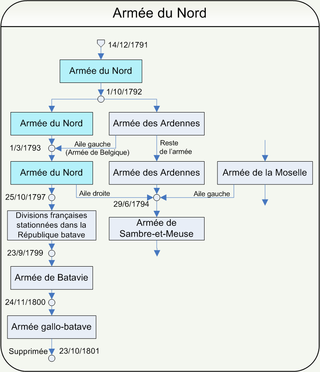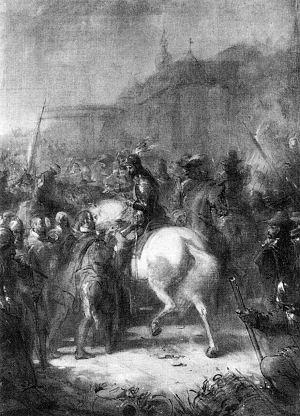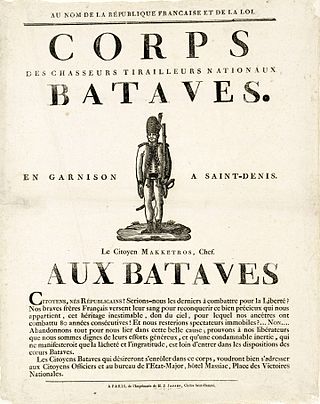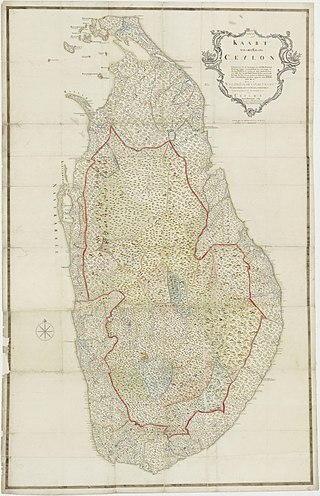
William I was King of the Netherlands and Grand Duke of Luxembourg from 1815 until his abdication in 1840.

William V was a prince of Orange and the last stadtholder of the Dutch Republic. He went into exile to London in 1795. He was furthermore ruler of the Principality of Orange-Nassau until his death in 1806. In that capacity he was succeeded by his son William.

Charles-François du Périer Dumouriez was a French military officer, minister of Foreign Affairs, minister of War in a Girondin cabinet and army general during the French Revolutionary War.

The Battle of Jemappes took place near the town of Jemappes in Hainaut, Austrian Netherlands, near Mons during the War of the First Coalition, part of the French Revolutionary Wars. One of the first major offensive battles of the war, it was a victory for the armies of the infant French Republic, and saw the French Armée du Nord, which included many inexperienced volunteers, defeat a substantially smaller regular Austrian army.

The Battle of Neerwinden saw a Republican French army led by Charles François Dumouriez attack a Coalition army commanded by Prince Josias of Saxe-Coburg-Saalfeld. The Coalition army of the Habsburg monarchy together with a small contingent of allied Dutch Republic troops repulsed all French assaults after bitter fighting and Dumouriez conceded defeat, withdrawing from the field. The French position in the Austrian Netherlands swiftly collapsed, ending the threat to the Dutch Republic and allowing Austria to regain control of its lost province. The War of the First Coalition engagement was fought at Neerwinden, located 57 kilometres (35 mi) east of Brussels in present-day Belgium.
The French Revolutionary Wars began on 20 April 1792 when the French Legislative Assembly declared war on Austria. This launched the War of the First Coalition.

Frederick Henry was the sovereign prince of Orange and stadtholder of Holland, Zeeland, Utrecht, Guelders, Overijssel in the Dutch Republic from 1625 until his death in 1647. In the last seven years of his life, he was also the stadtholder of Groningen (1640-1647).

Breda is a city and municipality in the southern part of the Netherlands, located in the province of North Brabant. The name derived from brede Aa and refers to the confluence of the rivers Mark and Aa. Breda has 185,072 inhabitants on 13 September 2022 and is part of the Brabantse Stedenrij; it is the ninth largest city/municipality in the country, and the third largest in North Brabant after Eindhoven and Tilburg. It is equidistant between Rotterdam and Antwerp.

David Hendrik, Baron Chassé was a Dutch soldier who fought both for and against Napoleon. He commanded the Third Netherlands Division that intervened at a crucial moment in the Battle of Waterloo. In 1830 he bombarded the city of Antwerp as commander of Antwerp Citadel during the Belgian Revolution.

The Army of the North or Armée du Nord is a name given to several historical units of the French Army. The first was one of the French Revolutionary Armies that fought with distinction against the First Coalition from 1792 to 1795. Others existed during the Peninsular War, the Hundred Days and the Franco-Prussian War.

The siege of 's-Hertogenbosch also known as the siege of Bois-Le-Duc was an action in 1629, during the Eighty Years' War and the Anglo–Spanish War in which a Dutch and English army captured the city of 's-Hertogenbosch. The city had been loyal to the King of Spain since 1579 and was part of the Spanish Netherlands.

The Low Countries theatre of the War of the First Coalition, in British historiography better known as the Flanders campaign, was a series of campaigns in the Low Countries conducted from 20 April 1792 to 7 June 1795 during the first years of the War of the First Coalition. As the French Revolution radicalised, the revolutionary National Convention and its predecessors broke the Catholic Church's power (1790), abolished the monarchy (1792) and even executed the deposed king Louis XVI of France (1793), vying to spread the Revolution beyond the new French Republic's borders, by violent means if necessary. The First Coalition, an alliance of reactionary states representing the Ancien Régime in Central and Western Europe – Habsburg Austria, Prussia, Great Britain, the Dutch Republic, Hanover and Hesse-Kassel – mobilised military forces along all the French frontiers, threatening to invade Revolutionary France and violently restore the monarchy. The subsequent combat operations along the French borders with the Low Countries and Germany became the primary theatre of the War of the First Coalition until March 1796, when Napoleon took over French command on the Italian front.

The Batavian Revolution in Amsterdam refers to the transfer of power in the city of Amsterdam on 18 January 1795 to a Revolutionary Committee of the new Batavian Republic. The same day the stadtholder of the Dutch Republic, William V, Prince of Orange fled the country. Amsterdam was the first city that declared itself in the Batavian Revolution that brought about the Batavian Republic.

The fourth siege of Breda was an important siege in the Eighty Years' War in which stadtholder Frederick Henry, Prince of Orange retook the city of Breda, which had last changed hands in 1625 when the Spanish general Ambrogio Spinola conquered it for the Spanish Habsburgs. Hereafter, the city would remain in the hands of the Dutch Republic until the end of the war.

The Batavian Legion was a unit of Dutch volunteers under French command, created and dissolved in 1793.
Louis-Charles de La Motte-Ango, vicomte de Flers joined the French Royal army and rose in rank to become a general officer in the French Revolutionary Wars. After serving in the Austrian Netherlands, he was appointed to command the Army of the Eastern Pyrenees. His army suffered several defeats in May and June 1793, but he rallied his troops to win a defensive victory at the Battle of Perpignan in July. The all-powerful Representatives-on-mission arrested him in August 1793 for a minor setback and sent him to Paris under arrest. The Committee of Public Safety executed him by guillotine on trumped up charges in the last days of the Reign of Terror. De Flers is one of the names inscribed under the Arc de Triomphe.

The Invasion of Ceylon was a military campaign fought as a series of amphibious operations between the summer of 1795 and spring of 1796 between the garrison of the Batavian colonies on the Indian Ocean island of Ceylon and a British invasion force sent from British India. The Dutch Republic had been a British ally during the French Revolutionary Wars, but was overrun by the French Republic in the winter of 1794 and reformed into the client state of the Batavian Republic. The British government, working with the exiled Stadtholder William of Orange, ordered the seizure of Batavian assets including colonies of the former Dutch Empire. Among the first territories to be attacked were those on the coast of the island of Ceylon, with operations initially focused on the trading port at Trincomalee.

The siege of Eindhoven, also known as the capture of Eindhoven of 1583, took place between 7 February and 23 April 1583 at Eindhoven, Duchy of Brabant, Spanish Netherlands during the Eighty Years' War and the Anglo-Spanish War (1585–1604). On 7 February 1583 a Spanish force sent by Don Alexander Farnese, Governor-General of the Spanish Netherlands, commanded by Karl von Mansfeld and Claude de Berlaymont, laid siege to Eindhoven, an important and strategic city of Brabant held by Dutch, Scottish, and French soldiers under the States' commander Hendrik van Bonnivet. After three months of siege, and the failed attempts by the States-General to assist Bonnivet's forces, the defenders surrendered to the Spaniards on 23 April.

The siege of Maastricht was a failed siege of the city of Maastricht by the forces of the French First Republic from 6 February to 2 March 1793, marking the final action of the 1793 campaign of the War of the First Coalition. The city was successfully defended by the Dutch garrison with the assistance of a small band of French Royalists.

The siege of Nijmegen occurred from 27 October to 8 November 1794 during the Flanders campaign of the War of the First Coalition. It was the last major military confrontation between the forces of the Revolutionary French First Republic and the reactionary First Coalition of European monarchs including William V, Prince of Orange, before the fall of the Dutch Republic in January 1795, which William had ruled as hereditary stadtholder since 1751. As commander-in-chief of the Dutch States Army, his indecision, several changes of mind and lack of coordination with his Anglo-Hanoverian, Hessian, Prussian and Austrian allies contributed to the eventual surrender of Nijmegen to the French revolutionaries.




















